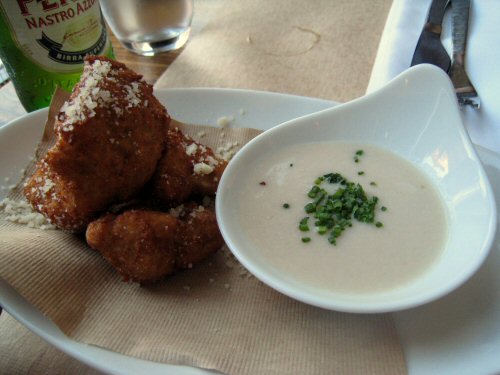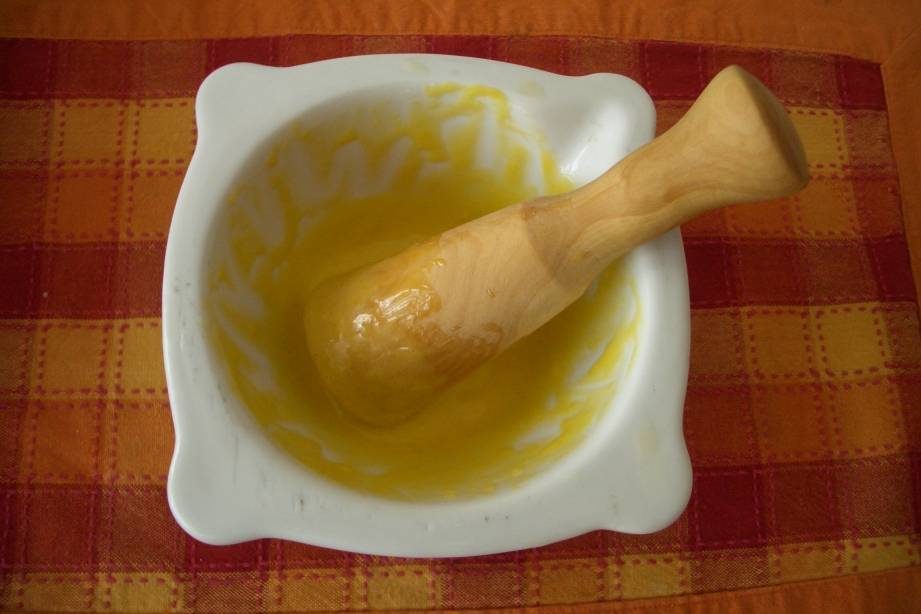|
Agliata
''Agliata'' (from , ; ; , ) is a pungent, savoury garlic sauce and condiment in Italian cuisine used to flavour and accompany grilled or boiled meats, fish and vegetables. It is first attested in ancient Rome, and it remains part of the cuisine of Liguria. ''Porrata'' is a similar sauce prepared with leeks in place of garlic. Preparation ''Agliata'' is prepared with crushed garlic, olive oil, bread crumbs, vinegar, salt and pepper. The bread crumbs are soaked in vinegar, which is then squeezed out, after which the garlic is whisked or beaten into the mixture. Its preparation includes the emulsion of the ingredients to prevent separation, which is performed by the olive oil being added in a slow drizzle while the mixture is constantly whisked. It generally accompanies grilled or boiled meat, fish and vegetables. History The origins of ''agliata'' date to ancient Rome. It has been described as a social-class crossover typical peasant food also used by upper-class people. ''The V ... [...More Info...] [...Related Items...] OR: [Wikipedia] [Google] [Baidu] |
Garlic Sauce
Garlic sauce is a sauce prepared using garlic as a primary ingredient. It is typically a pungent sauce, with the depth of garlic flavor determined by the amount of garlic used. The garlic is typically crushed or finely diced. Simple garlic sauce is composed of garlic and another ingredient to suspend it via emulsion, such as oil, butter or mayonnaise. Various additional ingredients can be used to prepare the sauce. Garlic sauce can be used to add flavor to many foods and dishes, such as steak, fish, seafood, mutton, chops, chicken, eggs and vegetables. It is also used as a condiment. Types Agliata Agliata is a savory and pungent garlic sauce and condiment in Italian cuisine used to flavor and accompany broiled or boiled meats, fish and vegetables. It is first attested in Ancient Rome, and it remains part of the cuisine of Liguria. Porrata is a similar sauce prepared with leeks in place of garlic. Aioli Aioli is a Mediterranean sauce made of garlic and olive oil; in some r ... [...More Info...] [...Related Items...] OR: [Wikipedia] [Google] [Baidu] |
Aioli
Aioli, allioli, or aïoli () is a cold sauce consisting of an emulsion of garlic and olive oil; it is found in the cuisines of the northwest Mediterranean cuisine, Mediterranean. The names mean "garlic and oil" in Catalan language, Catalan and Provençal Occitan, Provençal. It is found in the cuisines of the Mediterranean coasts of Spain (Catalonia, the Valencian Community, the Balearic Islands, Region of Murcia, Murcia, and eastern Andalusia) and France (Provence, Languedoc, Roussillon). Some versions of the sauce are closer to a garlic mayonnaise, incorporating egg yolks and lemon juice, whereas other versions lack egg yolk and contain more garlic. The latter gives the sauce a pastier texture, making it more laborious to produce as the emulsion is harder to stabilise. See als1900 (3rd ed.), p. 31at Archive.org. Johnston gives one recipe without extra flavorings (p. 75) and one with mustard (p. 229) There are many variations, such as adding lemon juice or other seasonings. I ... [...More Info...] [...Related Items...] OR: [Wikipedia] [Google] [Baidu] |
Peasant Food
Peasant foods are dishes eaten by peasants, made from accessible and inexpensive ingredients. In many historical periods, peasant foods have been stigmatized. Common types Meat-and-grain sausages or mushes Ground meat or meat scraps mixed with grain in approximately equal proportions, then often formed into a loaf, sliced, and fried * Balkenbrij * Black pudding * Boudin * Goetta, a pork or pork-and-beef and pinhead oats sausage * Groaty pudding * Haggis, a savory dish containing sheep's Offal, pluck (heart, liver, and lungs), Mincing, minced with onion, oatmeal, suet, spices, and salt, mixed with Stock (food), stock, and cooked while encased in a sheep's stomach * Knipp * Livermush * Lorne sausage * Meatloaf * Scrapple, a spiced mush of pig scraps, cornmeal and other flours fried up solid * Slatur Pasta * Pasta con i peperoni cruschi, an Italian pasta dish from Basilicata, defined a true representative of * Pasta e fagioli, a traditional Italian pasta soup * Pasta mollicat ... [...More Info...] [...Related Items...] OR: [Wikipedia] [Google] [Baidu] |
Toum
Salsat toum (Arabic for ), also known as toumiya () or simply toum (), is a garlic sauce common to the Levant. It is similar to the Provençal aioli. There are many variations; a common one contains garlic, salt, olive oil or vegetable oil, and lemon juice, traditionally crushed together using a wooden mortar and pestle. There is also a popular variation in Lebanon where mint is added; it is called (). Salsat toum is used as a dip, especially with french fries, chicken, and artichoke, and in Levantine sandwiches, especially those containing chicken. It is also commonly served with grilled chicken dishes, and can be served with almost any meat dish. See also * Garlic sauces: ** ** ** ** * List of Middle Eastern dishes * List of dips * List of garlic dishes * List of sauces The following is a list of notable Culinary art, culinary and prepared sauces used in cooking and food service. General * * * * * * * * * * * * * * * * * * * – Creamy ... [...More Info...] [...Related Items...] OR: [Wikipedia] [Google] [Baidu] |
Skordalia
Skordalia or skordhalia or skorthalia (Greek: σκορδαλιά , also called αλιάδα, aliada/aliatha) is a thick purée in Greek cuisine, made of garlic in a base of potatoes, walnuts, almonds or liquid-soaked stale bread mixed with olive oil in to make a smooth emulsion, to which some vinegar is added. It is usually made in a mortar and pestle. Skordalia is served as a sauce, side dish, or dip. It is mainly served with fried cod on the Greek national holiday of March 25th. Overview Skordalia is the modern equivalent of ancient ''skorothalmi''. The name, on the other hand, may be a pleonastic compound of Greek σκόρδο 'garlic' and Italian ''agliata'' 'garlicky'.Babiniotis, Λεξικό της Νέας Ελληνικής Γλώσσας Skordalia is usually served with batter- fried fish (notably salt cod, μπακαλιάρος), fried vegetables (notably eggplant and zucchini), poached fish, or boiled vegetables (notably beets). It is sometimes used as a ... [...More Info...] [...Related Items...] OR: [Wikipedia] [Google] [Baidu] |
Mujdei
''Mujdei'' (, plural: ''mujdeie'') is a traditional spicy Romanian sauce. It is made from garlic cloves crushed and ground into a paste, salted and mixed energetically with vegetable oil (almost always sunflower oil). Depending on regional preferences and the dish it is served with, lemon or other ingredients may be added. The result is a white sauce with a strong garlic flavor, varying in consistency from a thick paste to a runny sauce. In some parts of Romania ''mujdei'' is made out of cream, ground garlic, and salt. Sometimes ground garlic, salt, little water, oil and paprika powder. It is served with a variety of dishes, including fried fish, fried or grilled chicken or pork, rasol, and fried potatoes. The word ''mujdei'' is derived from the phrase ''must de ai'', meaning "garlic must (juice)". See also * Agliata – an Italian garlic sauce * Skordalia - a similar Greek garlic dip * Aioli * Toum * Garlic sauce * List of dips * List of garlic dishes * List of sauces ... [...More Info...] [...Related Items...] OR: [Wikipedia] [Google] [Baidu] |
List Of Sauces
The following is a list of notable Culinary art, culinary and prepared sauces used in cooking and food service. General * * * * * * * * * * * * * * * * * * * – Creamy sauce accompanies with seafood * * * * * * * (salsa roja) * * * – a velouté sauce flavored with tomato * * – prepared using mushrooms and lemon * * * * * * * * Prepared sauces * * * * * * * * * * * * * * * * * By type Brown sauces include: * * * * * * * * * * * Butter sauces * * * – Butter emulsified with water * Beurre noisette – Brown butter sauce * * Emulsified sauces * * * * * * * * * (w/ chilli) Fish sauces * * * * Green sauces * See Tomato sauces * * Hot sauces * Pepper sauces *Mustard sauces ** * Chile pepper-tinged sauces * Condiments made from hot sauce include: ** ** ** sauce ** sauce ** ** ** Meat-based sauces * * * * * * * * Pink sauces * See Pink sauce (disamb ... [...More Info...] [...Related Items...] OR: [Wikipedia] [Google] [Baidu] |
List Of Condiments
A condiment is a supplemental food (such as a sauce or powder) that is added to some foods to impart a particular flavor, enhance their flavor, or, in some cultures, to complement the dish, but that cannot stand alone as a dish. The term ''condiment'' originally described pickling, pickled or preserved foods, but now includes a great variety of flavorings. Many diverse condiments exist in various countries, regions and cultures. This list includes notable worldwide condiments. Condiments * * * * * * * * * * * * * * * * * * * * * * * * * * * * *Disodium inosinate – umami paste ** * ** * ** * * , jams, and jellies * * * * * ** ** ** * Harissa – North African paste of roasted red peppers, hot peppers, spices, oil, and other flavor ingredients * * * * * * * * * * * ** ** ** * * * * * * * * * * * Matbucha — a North African condiment * ** List of mayonnaises – List of mayonnaises * * * * * * * * ... [...More Info...] [...Related Items...] OR: [Wikipedia] [Google] [Baidu] |
Peasant Food
Peasant foods are dishes eaten by peasants, made from accessible and inexpensive ingredients. In many historical periods, peasant foods have been stigmatized. Common types Meat-and-grain sausages or mushes Ground meat or meat scraps mixed with grain in approximately equal proportions, then often formed into a loaf, sliced, and fried * Balkenbrij * Black pudding * Boudin * Goetta, a pork or pork-and-beef and pinhead oats sausage * Groaty pudding * Haggis, a savory dish containing sheep's Offal, pluck (heart, liver, and lungs), Mincing, minced with onion, oatmeal, suet, spices, and salt, mixed with Stock (food), stock, and cooked while encased in a sheep's stomach * Knipp * Livermush * Lorne sausage * Meatloaf * Scrapple, a spiced mush of pig scraps, cornmeal and other flours fried up solid * Slatur Pasta * Pasta con i peperoni cruschi, an Italian pasta dish from Basilicata, defined a true representative of * Pasta e fagioli, a traditional Italian pasta soup * Pasta mollicat ... [...More Info...] [...Related Items...] OR: [Wikipedia] [Google] [Baidu] |
Bread Crumbs
Breadcrumbs are a culinary ingredient consisting of flour or crumbled bread of varying dryness, sometimes with seasonings added. They are used for a variety of purposes, including breading or crumbing foods before frying (such as breaded cutlets like tonkatsu and schnitzel), topping casseroles, stuffing poultry, thickening stews, and adding inexpensive bulk to soups, meatloaves, and similar foods. Types Dry Dry breadcrumbs are made from dry breads which have been baked or toasted to remove most remaining moisture, and may have a sandy or even powdery texture. Breadcrumbs are most easily produced by pulverizing slices of bread in a food processor, using a steel blade to make coarse crumbs, or a grating blade to make fine crumbs. A grater or similar tool will also do. Fresh The breads used to make soft or fresh breadcrumbs are not quite as dry, so the crumbs are larger and produce a softer coating, crust, or stuffing. The ''crumb'' of ''breadcrumb'' also refers to th ... [...More Info...] [...Related Items...] OR: [Wikipedia] [Google] [Baidu] |
Liguria
Liguria (; ; , ) is a Regions of Italy, region of north-western Italy; its Capital city, capital is Genoa. Its territory is crossed by the Alps and the Apennine Mountains, Apennines Mountain chain, mountain range and is roughly coextensive with the former territory of the Republic of Genoa. Liguria is bordered by France (Provence-Alpes-Côte d'Azur) to the west, Piedmont to the north, and Emilia-Romagna and Tuscany to the east. It rests on the Ligurian Sea, and has a population of 1,509,908 as of 2025. The region is part of the Alps–Mediterranean Euroregion. Etymology The name ''Liguria'' predates Latin and is of obscure origin. The Latin adjectives (as in ) and ''Liguscus'' reveal the original root of the name, ''ligusc-'': in the Latin name -sc- was shortened to -s-, and later turned into the -r- of , according to rhotacism (sound change), rhotacism. Compare whence . The name derives from the ancient Ligures people, although the territory of this people was much larger th ... [...More Info...] [...Related Items...] OR: [Wikipedia] [Google] [Baidu] |
Sauces
In cooking, a sauce is a liquid, cream, or semi- solid food, served on or used in preparing other foods. Most sauces are not normally consumed by themselves; they add flavour, texture, and visual appeal to a dish. ''Sauce'' is a French word probably from the post-classical Latin ''salsa'', derived from the classical ''salsus'' 'salted'. Possibly the oldest recorded European sauce is garum, the fish sauce used by the Ancient Romans, while doubanjiang, the Chinese soy bean paste is mentioned in '' Rites of Zhou'' 20. Sauces need a liquid component. Sauces are an essential element in cuisines all over the world. Sauces may be used for sweet or savory dishes. They may be prepared and served cold, like mayonnaise, prepared cold but served lukewarm like pesto, cooked and served warm like bechamel or cooked and served cold like apple sauce. They may be freshly prepared by the cook, especially in restaurants, but today many sauces are sold premade and packaged like Worce ... [...More Info...] [...Related Items...] OR: [Wikipedia] [Google] [Baidu] |









